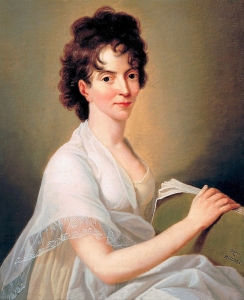Das Klavier, part 4. From: Mozart. Sein Charakter, sein Werk, by Alfred Einstein. (Zürich, Stuttgart 31953, S. 275-291. Permalink: www.zeno.org. Lizenz: Verwaist.)
________________________________________________________
Scores and recordings are available online in the excellent Digital Mozart Edition.
(A Project of the Mozarteum Foundation Salzburg and the Packard Humanities Institute.)
___________________________________________________________________
Mozart. The Piano [4].
… Six years passed before Mozart, in Vienna, again wrote out a piano sonata; which simply shows this was not needed. It was the time of his great academies [concerts], of his piano concertos, of quintets with winds, and the great violin sonatas. When an encore was needed, he improvised variations; as with those on Gluck’s “Unser dummer Pöbel meint” (K. 455), given as the song’s composer honored the academy of March 11, 1783 with his attendance. Mozart also improvised works in free form (“fantasies”) for these encores. And although for Mozart Vienna was “the true land of the piano”, it was also the land to conquer by string quartets, and even more with operas.
So in the first Vienna period, only the fragment of an Allegro in B flat (K. 400) appears, yet it grew enough to reach the recapitulation. From this Abbé Stadler could expand the work, completing it with some reliability. The work belongs to Mozart’s humorous gestures, still half-serious, given an artistic form. Energetic or even stormy early on, with both hands showing 16th note arpeggios and runs, this motion continues until the development where this vigor abates; giving way there to an exaggerated parody-like love declaration for [the sisters] “Sophie” and “Konstanze”, his future sister-in-law and spouse. It was the summer of 1781, the time where Mozart was enjoying “games and foolishness” with both girls – until things became quite serious. And as things became serious, Mozart no longer thought about adding the other, necessary movements to the first.
Marked seriousness rules the next sonata, written October 14, 1784. The work was dedicated to Mozart’s student Theresa von Trattnern, and listed as Op. 11. (Theresa von Trattnern was the second wife of the publisher and printer Johann Thomas von Trattnern.) The once available instructions for the sonata’s performance, including those for the “Fantasy” (K. 475) meant to precede it, were both lost, and with this one of the most important documents for Mozart’s aesthetic ideas. Did the instructions also contain more personal items, that had to be kept from later viewing? We do not know, and are not permitted to pry into the biographical secrets of the work.
Mozart – Fantasy in C minor K. 475.
Mozart- Piano Sonata in C minor, K. 457- 1st mov. Molto allegro.
Yet it is clear the work is a sudden outpouring of great agitation – no longer expressible in the fatalistic a minor of the Paris sonata, but in the pathos rich key of c minor – Beethoven’s: — and one is justified in calling this “beethovenisme d’avant la lettre”. By which we mean that this sonata contributed a great deal to the emergence of this Beethovenisme… (where) the concentration of the external movements contrasts with a broad, concerto-like adagio in solace-giving E flat; yet because of the truthful, all-paltry-solutions-refusing nature of the composer, does not lead to a finale in major: as the finale is even darker and full of pathos than the first movement. There is a disproportion in this work: the sonata form of the time is too narrow for the expansiveness of the emotional content; yet one admits that part of the work’s uncanny effect is due to the brevity of the first and last movements. A full expansion of emotion was provided for Mozart by the piano concerto form. Bearing this in mind, it is logical that the c minor sonata was followed by the piano concerto K. 491, where the content aligns perfectly with the vessel. Yet Mozart must have sensed the need to give the [c minor] sonata’s explosive quality a certain context, to justify it as the result of a special mental state; and so he placed the Fantasy of May 20, 1785 (K. 475) before the sonata, and had them published this way.
This fantasy, which gives us the truest image of Mozart’s immense abilities of improvisation – meaning the ability to maintain a convincing form, even with an apparently great freedom and facility of modulation, extreme contrasts of ideas, and an unforced interplay of the lyrical and virtuosic – this skill is so rich, it seems it might overpower the sonata – but does not. The fantasy also clarifies our understanding of other works by Mozart of this type: as with the less extensive fantasy in d minor (K. 397), apparently written in the first Vienna period; in which, in the highest sense, the childlike (or transcendent) Allegretto conclusion is a much too short “resolution”; so that we envision this work forming a whole, when serving as an introduction to a D major sonata, either K. 284 or 311 – or even for a D major sonata for piano and violin. The older connection of fantasy and fugue received Mozart’s attention too, in K. 394 in C major. Here the fantasy has the effect of a preliminary study – to be followed by its more powerful c minor companion [K. 475].
[To be continued.]
Translation by Edward Eggleston.

